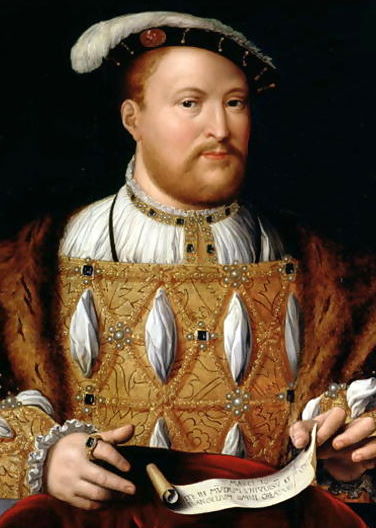King Henry VIII Controversies
Jump to navigation
Jump to search
| Historical Controversies about See Also:King Henry VIII “the man behind the myth is a psychological enigma” ~David Starkey “the ultimate unresolvable paradox of Tudor history” ~ Eric Ives Click EasyEdit to update this page! (Don't see the EasyEdit button above? <a href="/#signin" target="_self">Sign in</a> or <a href="/accountnew" target="_self">Sign up</a>.) |
"For a sovereign who has made such a splendid and momentous splash in history, Henry's character is strangely and frustratingly elusive. To contemporaries and moderns alike, the man appears as a Janus in which the satanic and the angelic are inexplicably opposed. At one moment Henry emerges as a beast, lustful and brutal, grasping and vengeful, vain and obstinate beyond belief; at the next instant the image changes and we perceive the superb athlete, the generous scholar, the accomplished diplomat and the idol of the realm... Ever since he died on January 28th, 1547, apologists and critics have been struggling to penetrate the ambivalence of Henry's personality. Two images keep merging and reappearing: the angelic-faced athlete who inherited a brimming treasury, a stable throne and boundless good health, and the Henry of later years who, in the most extreme language, died a pustular [diseased]...mass , degenerate both in body and in soul. How was it that the pleasant portrait of a cherubic-faced youth who heard up to five masses a day and coveted not his neighbour's goods should slowly give way to the harsh profile of a self-willed, if still charming, egotist with a suspicious and scheming mind that harbours its own counsel? The answers are many and contradictory. Henry may have concealed timidity and insecurity behind the bully's defences ; his prodigious vanity, his blustering gestures, and ostentatious desire to excel may have been the brittle veneer of over-compensation. Since the sixteenth century never experienced our modern pastime of psycho-analysis and preferred to reveal the hidden reaches of the mind and soul to the priest and not to the psychiatrist, history has been spared the knowledge of whether the King did in fact suffer from a complex, Oedipus or otherwise. A more fruitful, if equally elusive, explanation is that he suffered from a disease of the mind from megalomania brought on by a society that viewed its sovereign as the only possible bulwark against a renewal of civil war, and that was determined to worship him both as a paragon of a man and as the symbol of public peace and security. Certainly the worship of man as a god is apt to make him a devil" ~ Lacey Baldwin Smith A Tudor Tragedy |
| The Many Masks of Henry VIII: Even during his reign, Henry presented many different faces to many different people. Ambassadors to his court were puzzled by him, finding him mercurial of mood. It might be useful to remember that it is nearly impossible to view a historical figure without filtering him through the mores and values of our own time. He was known as: Bluff King Hal, Athlete, Statesman, The Defender of the Faith, One of the authors of the Reformation, Poet, Musician (expert singer with a clear tenor voice and able to sing at sight; a player of lute, flute, recorder, cornett and virginals; and a composer of sacred and secular music), Theologian, Writer and Lover. But also as: Megalomaniac, Lech, Despot, Insane, Ruthless, Murderer, Glutton, Vicious Oppressor of Protestants and Catholics alike. So Who was the Real Henry Behind the Masks? Henry VIII is the most instantly recognizable of English kings: the heavy, square face with its fringe of beard, the massive torso, arms akimbo, feet planted firmly on the ground. His character, too, is familiar: ‘Bluff King Hal’, gorging himself at the table, flagrantly promiscuous, cynically manipulating the Church to suit his marital aims, the very archetype of chauvinism. But scholarship reveals a very different Henry. Larger than life, certainly (six foot three inches to six foot four inches tall, a colossal height for the time); but, as a young man, clean-shaven and with a halo of red hair, his waist was a mere 35 inches and his chest 42 inches. His table manners were refined to the point of being finicky, and the conduct of his sexual liaisons was (according to the French ambassador) almost excessively discreet. Far from regarding the Church merely as an extension of his own power and wealth, Henry was devoutly religious and profoundly orthodox in his observances. (He would hear mass five times daily—though only three times if he was hunting!) As for his chauvinism, how can one defend his marital record: divorced, beheaded, died; divorced, beheaded, survived? Clearly one cannot! But his personal conduct to his queens was respectful and often tender. During divorce proceedings he was meticulous in his dealings with Katherine of Aragon, acknowledging the respect due to a queen of England who was herself the daughter of two monarchs. And poor Anne of Cleves (who Henry claimed made him impotent) reported: ‘When he comes to bed he kisses me, and taketh me by the hand and biddeth me “Good night, sweet heart”; and in the morning, kisses me and biddeth me “Farewell, darling”. This courtesy does not excuse the cruel divorces, still less the executions; but such accounts show a side of Henry at odds with the boor of popular myth. He appears to be a complex man of contradictions who still confounds us all these centuries later. |
| <embed allowfullscreen="true" height="340" src="http://widget.wetpaintserv.us/wiki/thetudorswiki/widget/youtubevideo/c9bb4ed09cdf6de6df8841b2f5562a713dddcfe3" type="application/x-shockwave-flash" width="560" wmode="transparent"/> A range of Tudor historians and historical fiction writer, Phillipa Gregory discuss the psychlogy of Henry VIII: insecure, tyrannical, generous, egotistical, cultured, sporting ? [Source: <a class="external" href="http://www.youtube.com/user/HistoricRoyalPalaces" rel="nofollow" target="_blank">HistoricRoyalPalaces</a> May 22, 2009] |
| Did Henry regret the death of Sir Thomas More and did he blame Anne Boleyn for it?: In general Henry was mostly concerned about his reputation and fearful of invasion. However, he also believed in the righteousness of his actions and angry towards those who did not share his own self perception. In this regard, Henry would have blamed one individual for the death of More – and that would be More himself for ‘daring’ to refuse him. Henry had relentlessly pursued More to bow to his will or face the consequences. There was nothing merciful about Henry's actions when examining the downfall of More. Henry was, in general, ferocious and unforgiving to opponents even when those who were not as open in their opposition wished for some form of compromise. When Henry voiced some regret about removing Thomas Cromwell, it seems that Henry briefly bemoaned the loss of someone who once did all his tedious paperwork as opposed to experiencing guilt over removing a friend. The remark was also made briefly and Henry subsequently pushed Cromwell out of his mind, just as he did successfully with the memories of other individuals, Anne Boleyn and Sir Thomas More included. While Henry certainly blamed Anne Boleyn for many things, her adultery was the cause of the breakdown of their marriage and he blamed her for failing to produce a living son and ultimately punished her for it in the end by casting her as a traitor and having her removed. But why would he blame the deaths of condemned traitors on her? Historian G.W. Bernard writes, ‘it was Henry who with increasingly passion saw More as a political enemy and threat and resolved that, if he did not submit, he would be destroyed’. Despite the international criticism Henry faced for this action, Henry would have been convinced that it was his absolute right to remove opponents in his realm. Secondary accounts have alleged Anne Boleyn’s involvement in More’s death, claiming that she goaded Henry to remove him but these accounts can be seen as both idealistic and biased. Could Henry have had regrets about More after having him executed, and then choose to ignore More’s theological position? We can likely assign this as a similar apocryphal story of Henry such as his last words allegedly being ‘Monks, Monks!’ to show his remorse over the actions towards the clergy and church as a whole. Neither Eric Ives’s or Retha Warnicke’s respective studies on Anne mention or give credence to any regret or blame of Anne on Henry's part. Even Chapuys whose suspect accounts of the couple's marital quarrels places more emphasis on Henry’s own anger towards these More and Fisher. His reports continue to emphasise Henry’s utter disregard for the two even after their deaths which makes the later claim that Henry blamed Anne to be somewhat illogical. John Guy in his work on Margaret Rope and the More family details very well the continuing open malice Henry showed towards the family after More's death which further indicates that Henry was not sorry for, and certainly not shy about, showing his own contempt for More even after 1535. [Source: <a class="external" href="http://www.youtube.com/user/littlemisssunnydale" rel="nofollow" target="_blank">littlemisssunnydale</a>] |
| The Jousting accident: During the time that Henry was married to Anne Boleyn, he fell from his horse while jousting in a tournament. It is thought that a joint in his armor broke, and cut him deeply in the leg. The wound seemed to heal with little trouble, which was rare at that time, when there were no antibiotics and knowledge of the necessity of keeping a wound clean. Some sources mention that the fall also knocked Henry unconscious for several hours -- some scholars have suggested that this head injury might be responsible for the changes that seemed to take place in his personality at this time in his life. After a few months, the wound opened again into an ulcer, which then followed a pattern of healing and reopening for the rest of Henry's life. Unfortunately, the medical treatments of the time were barbarous, including cutting into the wound to let out "bad humours", and the application of various ointments, including one that consisted of powdered pearls and lead mixed into a lard base. Because medical knowledge was so primitive at the time, this leg ulcer, possibly caused by a long-term untreated infection or cyst, was blamed for later ulceration and gangrene in Henry's feet and lower legs as he grew older. It was believed that there had been an infection of the original wound that spread downward, though the foot ulceration started years after the initial wound from the fall. Unfortunately, because of the paucity of information available to us, and the primitive state of medicine at the time, we will probably never know exactly what ailed Henry's leg. Historians have suggested that there was an injury to the bone which developed into chronic osteomylitis - for which the only effective contemporary treatment was removal of the infected bone. If Henry suffered from diabetes (see discussion below), he would have been more susceptible to osteomylitis. However, the initial leg injury seems to be a turning point in his life, so far as his health was concerned. Though he remained quite healthy and active during his short marriage to Jane Seymour, he gained a great deal of weight after her death, and by the time he was married to Anne of Cleves, there were reports that he had an ulceration of an old wound on his leg. His health slid rapidly downhill at that point, and he also aged markedly. |
| <a class="external" href="http://www.independent.co.uk/news/uk/this-britain/the-jousting-accident-that-turned-henry-viii-into-a-tyrant-1670421.html" rel="nofollow" target="_blank" title="Article from The Independant Newspaper">Article from The Independant Newspaper</a>: The jousting accident that turned Henry VIII into a tyrant Medical study uncovers turning point in king's life. Michael McCarthy reports Saturday, 18 April 2009 Henry VIII became the tyrannical monster remembered by history because of a personality change following a serious jousting accident, according to a new historical documentary. After the accident – just before he became estranged from the second of his six wives, Anne Boleyn – the king, once sporty and generous, became cruel, vicious and paranoid, his subjects began talking about him in a new way, and the turnover of his wives speeded up. The accident occurred at a tournament at Greenwich Palace on 24 January 1536 when 44-year-old Henry, in full armour, was thrown from his horse, itself armoured, which then fell on top of him. He was unconscious for two hours and was thought at first to have been fatally injured. But, although he recovered, the incident, which ended his jousting career, aggravated serious leg problems which plagued him for the rest of his life, and may well have caused an undetected brain injury which profoundly affected his personality, according to the History Channel documentary Inside the Body of Henry VIII. The programme focuses on the king's medical problems which grew worse in his later years, especially his ulcerated legs and his obesity: measurements of his armour show that, between his 20s and his 50s, the 6ft 1in monarch's waist grew from 32in to 52in, his chest expanded from 39in to 53in, and, by the time of his death in 1547 at the age of 56, he is likely to have weighed 28 stone. Robert Hutchinson, a biographer of Henry; Catherine Hood, a doctor; and the historian Lucy Worsley, who is chief curator of Britain's Historic Royal Palaces, offer a picture of a sovereign eventually overwhelmed by health problems by the time of his death. His doctors recorded that he had badly ulcerated legs, was unable to walk, his eyesight was fading, and he was plagued by paranoia and melancholy. However, Henry had started out with excellent health as a young man, being universally admired for his manly physique. An ambassador at the Tudor court reported: "His Majesty is the most handsomest potentate I have ever set eyes on. Above the usual height with an extremely fine calf to his leg and a round face so very beautiful it would become a pretty woman." He may have had a bout of smallpox at the age of 23, but the experts speculate that his real medical problems began at the age of 30 when he appears to have contracted malaria, which is thought to have returned throughout his life. They were intensified by two factors: open sores on his legs and sporting injuries. The sores – varicose ulcers, which began on his left leg when he was 36, and later affected his right – may have been caused by the restrictive garters he wore to show off his calves. They never healed, and increasingly restricted his mobility. Henry also suffered various injuries because of his well-known love of sports – he excelled at pursuits such as archery, wrestling and real tennis, and, playing the latter game he seriously injured his foot. But it was jousting – two armoured horsemen charging at each other with wooden lances in "the lists" – which proved the most dangerous. His first serious accident occurred in 1524 when he failed to lower the visor on his helmet and was hit by his opponent's lance just above the right eye, after which he constantly suffered from migraines. Jousting nearly killed him 12 years later. The fall at Greenwich left him "speechless" for two hours, and Anne Boleyn, the woman for whom he had divorced his original queen, Katherine of Aragon, was told that he would die – the shock of which news, she said, caused her to miscarry the child she was expecting. The miscarried baby was male, and it was immediately after this that Henry told Anne they would clearly never have male children together, and turned against her. Less than six months later Anne had been executed and Henry had married the third of his six wives, Jane Seymour. But the jousting accident may have affected his whole personality, the experts suggest. "We posit that his jousting accident of 1536 provides the explanation for his personality change from sporty, promising, generous young prince, to cruel, paranoid and vicious tyrant," Lucy Worsley says. "From that date the turnover of the wives really speeds up, and people begin to talk about him in quite a new and negative way. "After the accident he was unconscious for two hours; even five minutes of unconsciousness is considered to be a major trauma today." Henry may have suffered a brain injury, Dr Worsley says. "Damage to the frontal lobe of the brain can perfectly well result in personality change." What is beyond doubt is that the end of his jousting combined with his leg ulcers to restrict his movement and Henry, who had a large appetite anyway, began to put on weight rapidly. The programme reconstructs his diet, suggesting he may have eaten up to 13 dishes a day, the majority comprising meat such as lamb, chicken, beef, game, rabbit, and a variety of birds like peacock and swan, and he may have drunk 10 pints of ale a day as well as wine, as water was unsafe. Henry, the programme says, "became a comfort-eating paranoid recluse – a 28 stone man-mountain." |
Did Henry suffer from Syphilis?:
There are many schools of thought concerning Henry's possible medical condition, and the suspicion that he might have suffered from syphilis has been around since Henry's lifetime. Unfortunately, it is very difficult to determine after the fact just what disease Henry VIII might have had and there is considerable debate as to what it might have been. The traditional explanation for his leg ulceration and mental decline in later life is syphilis, which is also in keeping with the traditional figure of Henry VIII the lecher. This is similar to the traditional contention that the Tudors all died of tuberculosis, which has also been called into question by some historians. It is important to remember that during Henry's lifetime, medicine was extremely primitive. Any condition that caused ulceration anywhere on the body was referred to generically as "the pox", which was also a common name for syphilis. These ulcerative conditions could, and did include smallpox, chickenpox, the ulceration caused by late term diabetes, and any other spreading skin rash or sores, which were quite common considering the poor sanitary conditions of the day. Similarly, any disease which caused its victims to waste away was called "consumption", and could include any illness that caused the patient to become emaciated -- cancer, diabetes type I, tuberculosis, parasitic infections. But because of these generic terms being used to describe a number of conditions in Henry's day, the traditional belief that Henry died of syphilis, and his son, Edward, died of tuberculosis, has continued. It is known that Henry suffered for many years from an ulcerative condition of the legs. Syphilis typically attacks mucous membranes -- the genitals, eyes and nasal lining are the most common sites for syphilitic ulceration, resulting in the typical genital lesions, blindness and collapse of the nasal cartilage that is associated with advanced syphilis. Henry's leg ulceration seemed to start in one leg after an injury in a jousting accident. This injury healed with little complication -- only to reopen a few years later. Eventually, both of Henry's legs and feet were affected with ulcers. It was noted by his physicians that his toes became gangrenous as the condition advanced. This is an ulceration pattern far more typical of advanced diabetes, both Type I and Type II. There is no documentation of Henry having suffered from ulceration of the mucous membranes. Henry's gradual mental impairment, mainly a temper which became increasingly irascible with age, as well as paranoia, has frequently been blamed on the insanity which accompanies tertiary syphilis, as the syphilis spirochetes attack the brain tissue (this commonly occurs when the nasal passages have been infected and damaged, due to their proximity to the brain). However, Henry also had a series of strokes prior to his death, which would point to circulatory and blood pressure problems, which could have been caused by late stage diabetes or arteriosclerosis. Circulatory insufficiency to the brain is a common cause of degenerative mental illness. Henry's older sister, Margaret, also suffered similar progressive mental impairment and strokes. It would be hard to prove that both Henry and Margaret had syphilis-- but it is very likely they both suffered from some hereditary circulatory impairment. It has recently been proven that the preponderance toward developing diabetes is genetic. Since the rest of Henry's siblings died of wasting diseases in childhood or early adolescence, with the exception of his younger sister, Mary, who died of a similar wasting disease during pregnancy, and since such wasting away during childhood, adolescence and pregnancy is a symptom of untreated juvenile (Type I) diabetes, I tend to lean away from the Henry with syphilis theory and more toward the Henry with diabetes or another circulatory disorder theory. As for Henry's increasing mental instability, decreased circulation to the brain could definitely have been a contributing factor. This sort of mental instability is common in cases of untreated diabetes, as it is in cases of arteriosclerosis (hardening of the arteries) and Alzheimer's disease. Henry himself frequently complained of the stress and burden that being King placed upon him. These complaints increased as he grew older. His daughter, Elizabeth, who also reigned for many years, complained similarly, and suffered from periods of depression as she grew older. During the Tudor period, monarchs were absolute -- the king or queen WAS the country. They were surrounded by endless political manoeuvrings and machinations. The intrigues of Henry's court alone could fill dozens of books, as one courtier after another tried to win a high ranking place in the scheme of things -- and Henry was well aware that such manoeuvrings went on. He frequently stated that he felt that he could trust no-one -- and this was pretty much the case! This solitary position, feeling that you were without any close confidante or companion, might not be difficult for a young monarch to tolerate, but as the infirmities of age began to set in, the loneliness must have been incredible. Henry frequently complained of isolation and loneliness, and often wished, in his final years, "to be just a man". It's not unreasonable to assume that this sort of stress would lead to some mental aberration. Also, in his final years, Henry was subjected to terribly primitive and painful medical practices, as his ulcerated legs grew worse. The ulcers were continually cut into, lanced, cauterized, and then dressed with an ointment that contained ground pearls and lead! Medical procedures were not only primitive, but were carried out under completely unsanitary conditions. Henry's legs were continually infected and under siege from physicians who cut into them and burned them. The pain was continual and severe, frequently causing the old King to cry out in pain. Henry's sleep was disturbed by the continual pain, and his mental health was definitely affected by it. This ordeal alone would be likely to drive anyone into insanity, and Henry was unwell besides, suffering from dropsy (an edema resulting from impaired circulation, which caused enormous swelling of the entire body) and some mental impairment after his strokes. The lead poisoning coming from that pearl and lead ointment alone would have been enough to cause mental illness. There have been some theories posted on the Internet that Henry's children all suffered from congenital syphilis. This is very, very unlikely, as congenital syphilis is almost always accompanied by mental retardation, and all three of Henry's legitimate children, as well as his illegitimate son, Henry Fitzroy, were very intelligent and excellent scholars. There are varying schools of thought about the cause of Edward's death -- like many young Tudors before him, he wasted away prior to his death, and his final illness has been traditionally believed to be tuberculosis. However, he had also contracted either smallpox or measles in the year before he died, and his wasting could also be attributed to diabetes, which frequently becomes severe during the growth spurts of adolescence. It is known that he was treated with medicines that contained arsenic, and that he had many of the symptoms of arsenic poisoning while on his deathbed (his hair and nails had fallen out, he was covered with ulcers, and there was a peculiar smell, similar to garlic, on his breath). Many medicines used at the time contained arsenic, and it was sometimes added to wine as well, so whether Edward's death was hastened by deliberate poisoning or not is questionable. Mary I, who reigned after Edward, was a middle aged woman with a long history of migraine headache, severe dental problems with accompanying sinus complications and menstrual irregularity. She had not enjoyed good health since her childhood, and it is very likely that the incredible stress that she experienced during her teens and early adulthood, when her mother was in exile and her own legitimacy was in question (to say nothing of her life frequently being in danger) led to the development of some of her ailments. During her brief reign, she suffered from two hysterical pregnancies. Her belief that she was pregnant was intensified by the presence of symptoms that she thought were linked with pregnancy -- cessation of menstruation, nausea and swelling of the abdomen. It is more likely that these symptoms were caused by cancer of the ovaries and uterus. However, it has been recently been suggested that Mary suffered from a pituitary tumour. This could have caused her headaches, erratic menstruation and deteriorating eyesight, as well as the later symptoms mistaken for those of pregnancy. It is significant that Mary experienced lactation (milk coming from her breasts) as well as abdomenal swelling, and that her doctors also believed that she was pregnant. A pituitary tumour would have been impossible to diagnose in the sixteenth century. The idea that Elizabeth I was a sufferer of congenital syphilis is almost laughable. Though she suffered from a few ailments, one of the notable things about her was her robust health. She was very active, and believed that engaging in regular exercise daily, as well as maintaining a strict diet, was the key to keeping a vigorous body and mind. She danced several galliards (a very taxing and lively dance) every morning as her exercise, rode frequently, walked, played tennis and exhibited physical energy uncommon in a woman of her time. In her later years she did complain of stomach ailments, and it is probably true that her teeth darkened with decay over the years, but her overall health was far too robust and complete for her to have been a congenital syphilitic. The question of Henry's exact health ailment, like many other questions about him, will probably never be satisfactorily answered, short of an exhumation of his grave and a post-mortem being carried out -- which is highly unlikely. Even if such a thing should occur, it is a long time since Henry's death -- there are some things that we will never definitively know. Trying to diagnose a health condition five hundred years after the fact, using the doctors' notes made at a time when medicine was extremely primitive (and the notes may very well have been 'censored', since they were about the King) is basically a guessing game. There are five hundred years' worth of legends about Henry, and his ulcerated leg and many marriages are a part of them. It is probably safe to say that during the later part of his reign he was greatly feared and hated by many -- and during the reigns of Edward and particularly Mary, he was not a loved figure. Claiming that he died of "the pox" would have fit in with the demonizing that took place during this time -- the much married, bloodthirsty lecher was killed by a disease that was the result of his own evil and corrupt way of living. Death by syphilis is part of the legend of Henry VIII -- and like so many of the other parts of the legend, a definitive answer is something that we will never have. |
| <embed allowfullscreen="true" height="350" src="http://widget.wetpaintserv.us/wiki/thetudorswiki/widget/youtubevideo/50c3ecde29cf78dbb5403bf494e2718213d3e86e" type="application/x-shockwave-flash" width="425" wmode="transparent"/> Experts discuss the likely causes of the death of Henry VIII on 28 Jan 1547. [source: <a class="external" href="http://www.youtube.com/user/HistoricRoyalPalaces" rel="nofollow" target="_blank">HistoricRoyalPalaces</a>May 22, 2009] |
| So what happened to Henry? : If it wasn't syphilis, how did the Young Promising King Henry of 1509 turn into the irrational, despotic, absolute ruler of his middle and later years? One recently posed theory makes a lot of sense. DIABETES 2. The devastating effects of this disease when untreated, as it would have been in Henry's time, can explain many of the mysteries surrounding the Tudors. Tudors died young, with a few exceptions. Henry originally had six brothers and sisters. Only three survived to become adults. The others fell pray to a "wasting" condition termed "consumption", where the victim would progressively grow thinner and weaker, eventually dying. These are the symptoms of diabetic ketoacidosis, which can claim the lives of untreated diabetics. In fact, when Henry's brother, Arthur, was dying, he asked repeatedly for water. His thirst was overwhelming, another diabetic symptom. Henry and his sisters, Margaret and Mary, survived into adulthood. Mary died as a young adult, after several pregnancies, of the same "wasting" disease that claimed the Tudor siblings who did not survive childhood. Margaret suffered a series of strokes in middle and later life, and also showed signs of progressive dementia before her death, much like Henry. Many of Henry's symptoms, his leg ulcer, the strokes he suffered in later life, his wild mood swings, his progressive dementia all point toward severe uncontrolled diabetes. Comments: There are two different kinds of diabetes, and the origin and pathophysiology of both are *completely* different. It is very possible that people in his family may have suffered this, especially if they were constantly thirsty (a classic symptom of Type 1); HOWEVER, Type 1 diabetics who are not treated with insulin (as they obviously weren't in that period) are VERY unlikely to ever get fat because in Type 1 the body is constantly breaking down fat as a last resort to get energy (since cells cannot get that energy from its usual source, sugar). As a result, they often die young. Also, Type 1 diabetes does not have a strong genetic predisposition, so you won't see it "running in families." Type 2, on the other hand, *is* what I believe Henry VIII might have suffered from. Type 2 Diabetes is a syndrome of *resistance* to insulin (the hormone that causes cells to absorb sugar for energy) that usually occurs BECAUSE of increased body weight. However, because cells still retain the ability to absorb some sugar, sufferers don't waste away like Type 1 diabetics do. That said, the increased body sugar destroys blood vessels over time, leading to other symptoms classic of Type 2 such as non-healing wounds and infections (Henry's leg!!), blurred vision, neuropathy, kidney failure, etc. Also, Type 1 has not been shown to be HEREDITARY (i.e. seen in families), especially to the degree that Type 2 has |
| Click here for Video clip :<a class="external" href="http://www.youtube.com/watch?v=MbgcDxAQSgQ" rel="nofollow" target="_blank" title="Henry VIII's Diet">Henry VIII's Diet</a> - In this short video, the diet of Henry VIII is recreated in a modern day weekly supermarket shop. Historian Dr Lucy Worsley and medical doctor Catherine Hood also examine the possibility that Henry VIII suffered from type 2 diabetes [Source: <a class="external" href="http://www.youtube.com/user/littlemisssunnydale" rel="nofollow" target="_blank">littlemisssunnydale</a>] |
| How much did Henry weigh?: At the time of Henry's death, between obesity and fluid retention caused by circulatory problems, he was enormous, and it took four strong men to lift and carry the sedan chair that he was carried around in. His coffin, which was lined with lead, was so heavy that it broke the supports that were provided for it in at least one of the churches it was displayed in. We know from seeing Henry's armour (he had several sets made a different times in his life), and from measurements taken of his skeleton about 200 years after his death, that he was probably around six foot, two to six foot three inches tall during his lifetime. His early armour indicated an athletically built man with a small waistline -- he probably would have weighed in the neighborhood of 180 to 200 pounds at this time. There are a couple of other sets of armour in existence, including one made for his final invasion of France in the last two years of his life. The waist on this last set of armour would fit a waist of about 58 to 60 inches, as compared to the first set of armour which would have fit a waist of about 34 to 36 inches. At the time that Henry had the last set of armour made, his weight was probably at around 300 pounds. After his return from France, he entered the time of his final illness, where his body became very bloated from fluid retention (called "dropsy" in those days, because the patient's hands would swell so much that their grasp was impaired, causing them to drop things). So it is likely that Henry probably weighed well in excess of 300 pounds by the time of his death. Though these sizes, particularly of the first suit of armour, don't seem that enormous to us today, it should be noted that in Henry's time, people were shorter and smaller than they are now, due to lack of proper nutrition and health care. However, it is a myth that people were a lot shorter - recent excavations and studies of the skeletons from the 'Mary Rose' indicate that Tudor men and women were, on average, two or three inches smaller than their modern counterparts. But at the modern equivalent of more than 6 foot 5 inches, Henry was almost literally considered a giant in his time. His size had much to do with the glamour associated with him when he was a younger man -- and with the stories of his enormous size as an older man. Also, as he began to become heavy, Henry insisted that all his clothes be designed to hide his expanding waistline, which is why he adopted the extreme padded shoulders that are seen in his later portraits. By the time he died, his clothing literally extended as wide as he was tall, to create an image of a man with very wide shoulders and a powerful build, rather than the "pear shaped" body that was hidden underneath them. |
| Sources: | LINKS:
|






